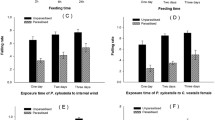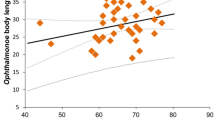Abstract
The present paper aims to assess the host-selectivity and host-switching behaviour of the comatulid associated ophiuroid Gymnolohpus obscura. The relationships between size-structure, distribution and infestation characteristics of G. obscura were assessed among all available feather star species in the Bay of Nhatrang, Vietnam, together with the frequency of injuries among symbiont size classes. Our data show that despite the fairly wide host distribution ranges, not all of them are equally infested by G. obscura, likely because of host morphology, size and location on the substrate. The most preferred hosts were the comatulids Comaster nobilis and Comanthus parvicirrus, which were preferably infested by larger symbionts. The highest frequency of injuries was found in symbionts with disks ranging from 0.6 to1 cm in diameter, tracing a host-to-host migration behaviour leading to a sharp fall in abundance in the 1.1–1.5 cm size class. Our results suggest that host-switching (either between the same or among different host species) is a characteristic behaviour of G. obscura, driven by either intraspecific competition and/or by searching for more favourable trophic or protective conditions.





Similar content being viewed by others
References
Baeza JA, Stotz W (2001) Host-use pattern and host-selection during ontogeny of the commensal crab Allopetrolisthes spinifrons (H. Milne Edwards, 1837) (Decapoda: Anomura: Porcellanidae). J Nat Hist 35:341–355
Baeza JA, Thiel M (2007) The mating system of symbiotic crustaceans. A conceptual model based on optimality and ecological constraints. In: DuVy JE, Thiel M (eds) Reproductive and social behavior: crustaceans as model systems. Oxford University Press, Oxford, pp 250–267
Baeza JA, Stotz W, Thiel M (2001) Life history of Allopetrolisthes spinifrons (H.M. Edwards, 1837), a crab associate of the sea anemone Phymactis clematis. J Mar Biol Ass UK 81:69–76
Barel CDN, Kramers PGN (1977) A survey of the echinoderm associates of the North-East Atlantic area. Zoologische Verhandelingen 156:1–159
Bell JL (1984) Changing residence: dynamics of the symbiotic relationship between Dissodactylus mellitae Rathbun (Pinnotheridae) and Mellita quinquiesperforata (Leske) (Echinodermata). J Exp Mar Biol Ecol 82:101–115
Bourgoin A, Guillou M (1994) Arm regeneration in two populations of Acrocnida brachiata (Montagu) (Echinodermata: Ophiuroidea) in Douarnenez Bay (Brittany, France): an ecological significance. J Exp Mar Biol Ecol 184:123–139
Britayev TA (1991) Life cycle of the symbiotic scaleworm Arctonoe vittata (Polychaeta: Polynoidae). Ophelia 5:305–312
Britayev TA, Smurov AV (1985) The structure of a population of symbionts and related biological features, Arctonoe vittata (Polychaeta, Polynoidae) taken as an example. Zhurnal obschey Biologii 46(3):355–366 (In Russian, English summary)
Britayev TA, Smurov AV, Adrianov AV, Bazhin AG, Rhzavsky AV (1989) Ecology of symbiotic Polychaete Arctonoe vittata according to the peculiarity of starfish Asterias ratbunae ecology. [In Russian]. In: Sveshnikov VA (ed) Symbiosis among marine animals. A.N. Severtzov Institute, Russian Academy of Sciences, Moscow, pp 102–127
Britayev TA, Martin D, Krylova EM, von Cosel R, Aksiuk TS (2007) Life-history traits of the symbiotic scale-worm Branchipolynoe seepensis and its relationships with host mussels of the genus Bathymodiolus from hydrothermal vents. Mar Ecol 28:36–48
Castro P (1978) Movements between corals colonies in Trapezia ferruginia (Crustacea: Brachyura), an obligate symbiont of scleractinian corals. Mar Biol 46:237–245
Chang KH, Chen YS, Chen CP (1987) Xanthid crabs in the corals, Pocillopora damicornis and P. verrucosa of southern Taiwan. Bull Mar Sci 41:214–220
Clark AH (1921) A monograph of the existing crinoids. Bul US Nat Mus 82(2) (Parasites and Commensals)):616–660
Clements LAJ, Bell SS, Kurdziel JP (1994) Abundance and arm loss of the infaunal britlestar Ophiophragmus filograneus (Echinodermata: Ophiuroidea), with an experimental determination of regeneration rates in natural and planted seagrass beds. Mar Biol 121:97–104
Coppard SE, Campbell AC (2004) Organisms associated with diadematid echinoids in Fiji. Echinoderms: München. Taylor & Francis, London, pp 171–176
De Bruyn C, David B, De Ridder C, Rigaud T (2010) Asymmetric exploitation of two echinoid host species by a parasitic pea crab and its consequences for the parasitic life cycle. Mar Ecol Prog Ser 398:183–191. https://doi.org/10.3354/meps08315
De Bruyn C, De Ridder C, Rigaud T, David B (2011) Chemical host detection and differential attraction in a parasitic pea crab infecting two echinoids. J Exp Mar Biol Ecol 397:173–178. https://doi.org/10.1016/j.jembe.2010.12.005
Deheyn D, Lyskin SA, Eeckahaut I (2006) Assemblages of symbionts in tropical shallow-water crinoids and assessment of symbionts' host-specificity. Symbiosis 42:161–168
Dgebuadze PY, Mehova ES, Britayev TA (2012) Recolonization of the Himerometra robustipinna (Himerometridae, Crinoidea) by macrosymbionts: an in situ experiment. Symbiosis 58:253–258
Dimock RV Jr (1974) Intraspecific aggression and the distribution of a symbiotic polychaete on its host. In: Vernberg A (ed) Symbiosis in the sea. University of South Carolina Press, Columbia, pp 29–44
Fourgon D, Jangoux M, Eeckhaut I (2007) Biology o f a “babysitting” symbiosis in brittle stars; analysis of the interactions between Ophiomastix venosa and Ophiocoma scolopendrina. Invertebr Biol 126:385–395
Grange KR (1991) Mutualism between the antipatharian Antipathes fiordensis and the ophiuroid Astrobrachion constrictum in New Zealand fjords. Hydrobiologia 216–217:297–303
Hendler G (1984) The association of Ophiothrix lineata and Callyspongia vaginalis: a brittlestar-sponge cleaning symbiosis? PSZN I: Mar Ecol 5:9–27. https://doi.org/10.1111/j.1439-0485.1984.tb00304.x
Hendler G, Grygier MJ, Maldonado E, Denton J (1999) Babysitting brittle stars: heterospecific symbiosis between ophiuroids (Echinodermata). Invertebr Biol 118:190–201. https://doi.org/10.2307/3227060
Huang HD, Rittschof D, Jeng MS (2005) Multispecies associations of macrosymbionts on the comatulid crinoid Comanthina schlegeli (Carpenter) in southern Taiwan. Symbiosis 39:47–51
Ivlev BC (1955) Expiremental ecology of fish feeding. Moscow, Pisheprom, pp 1–252
James DB (1995) Animal associations in echinoderms. J Mar Biol Assoc India 37:272–276
Jangoux M (1987a) (a) Diseases of Echinodermata. 11. Agents metazoans (Mesozoa to Bryozoa). Dis Aquat Org 2:205–234
Jangoux M (1987b) (b) Diseases of Echinodermata. 111. Agents metazoans (Annelida to Pisces). Dis Aquat Org 3:59–83
Kasumyan А О, Тinkova Т V, Isaeva О М, Britaev Т А, Dgebuadze PYu, Оanh L Т К (2014) Taste deterrency of marine tropical hydrobionts as tools for chemical defense against fish. [In Russian]. In Fish behavior. V Russian conference. 8–9 November 2014, Borok, Russian Federation. Kostroma:Kostromskoy pechatny dom, pp 101–106
Lechowicz MJ (1982) The sampling characteristics of electivity indices. Oecologia 52:22–30
Linsday SM (2010) Frequency of injury and the ecology of regeneration in marine benthic invertebrates. Integr Comp Biol 50(4):479–493
Loehle C, Rittenhouse LR (1982) An analysis of forage preference indices. J Range Manage 35(3):316–319
Lyskin SA, Britaev TA (2005) Symbionts of holothurians from South Vietnam: intra- and interspecific interactions. Dokl Biol Sci 401:116–119
Mekhova ES, Britayev TA (2012) Feather stars (Crinoidea, Comatulida) of Nhatrang Bay, Vietnam: fauna, habitat and symbionts. In: Britayev TA, Pavlov DS (eds) Benthic fauna of the Bay of Nhatrang, Southern Vietnam, vol 2. KMK Press, Moscow, pp 447–478
Mekhova ES, Dgebuadze PY, Mikheev VN, Britayev TA (2015) Colonization of depopulated crinoids by symbionts: who comes from the bottom and who from the water column? J Mar Biol Assoc U K 8:1607–1612
Mikheev VN, Pasternak AF, Valtonen ET (2007) Host specificity of Argulus coregoni (Crustacea: Branchiura) increases at maturation. Parasitology 134:1767–1774
Morton B, Mladenov PV (1992) The associates of Tropiometra afra-macrodiscus (Echinodermata: Crinoidea) in Hong Kong. In: Morton B (ed) The Marine Flora and Fauna of Hong Kong and Southern China III. Hong Kong University Press, Hong Kong, pp 431–438
Mosher CV, Watling L (2009) Partners for life: a brittle star and its octocoral host. Mar Ecol Prog Ser 397:81–88. https://doi.org/10.3354/meps08113
Munday BW (1993) Field occurrence and significance of regeneration in Amphiura chiajei (Echinodermata: Ophiuroidea) from Killary Harbour, west coast of Ireland. Mar Biol 115:661–668
Nigam NK, Raghunathan C (2016) New record of crinoid associated brittle star Gymnolophus obscura (Ljungman, 1976) from Andaman and Nicobar Islands, India. World J Fish Mar Sci 8(1):06–09
Ohtsuka S, Kondo Y, Sakai Y, Shimazu T, Shimomura M, Komai T et al (2010) In-situ observations of symbionts on medusae occurring in Japan, Thailand, Indonesia and Malaysia. Bulletin of the Hiroshima University Museum 2:9–18
Poulin R (2005) relative infection levels and taxonomic distances among the host species used by parasites: insights into parasite specialization. Parasitology 130:109–115
Preston EM (1973) A computer simulation of competition among five sympatric congeneric species of xanthid crabs. Ecology 54:469–483
Price A, Rowe F (1996) Indian Ocean echinoderms collected during the Sindbad Voyage (1980-81): 3. Ophiuroidea and Echinoidea. Bull nat Hist Mus Lond (Zool.) 62(2):71–82
Stohr S, O’Hara T, Thuy B (2012) Global diversity of brittle stars (Echinodermata: Ophiuroidea) PLoS ONE/www.plosone.org 7(3) e31940:1–14
Thiel M, Zander A, Baeza JA (2003) Movement of the symbiotic crab Liopetrolisthes mitra between its host sea urchin Tetrapygus niger. Bull Mar Sci 72(1):89–101
Tinkova TV, Kasumyan AO, Dgebuadze PY, Oanh LTK, Britaev TA (2014) Deterrence of feather stars (Crinoidea, Comatulida) from Southern Vietnam for the Indo-Pacific sergeant-fish Abudefduf vaigiensis. Dokl Biol Sci 456:195–198
Tokaji H, Nakahara K, Goshima S (2014) Host switching improves survival rate of the symbiotic polychaete Arctonoe vittata. Plank Benth Res 9(4):189–196
Wirtz P, Diesel R (1983) The Social Structure of Inachus phalangium, a Spider Crab Associated with the Sea Anemone Anemonia sulcata. Ethology 62:209–234. https://doi.org/10.1111/j.1439-0310.1983.tb02152.x
Yanagisawa Y, Hamaishi A (1986) Mate acquisition by a solitary crab Zebrida adamsii, a symbiont of the sea urchin. J Ethol 4:153–162
Acknowledgements
The authors would like to thank the administration and staff of the Coastal Branch of the Russian-Vietnam Tropical Center for their help in organizing and conducting field studies, Dr. P. Dgebuadze, O. Savinkin, Yu. Deart for their help and collaborative work in the field and in the laboratory, and Dr. V.N. Mikheev for fruitful discussion of the manuscript. We are also grateful to two anonymous reviewers and the editor for their useful comments and text corrections. Material processing and preparation of the manuscript were supported by the Russian Foundation for Basic Research; project no. 18-05-00459. This study was also supported by a research project of MSU Zoological Museum (AAAA-A16-116021660077-3, depository of specimens) and The Russian Science Foundation (grant 14-50-00029, morphological and taxonomic study).
Author information
Authors and Affiliations
Corresponding author
Rights and permissions
About this article
Cite this article
Mekhova, E.S., Martynov, A.V. & Britayev, T.A. Host selection and host switching in Gymnolophus obscura – a symbiotic ophiuroid associated with feather stars (Crinoidea: Comatulida). Symbiosis 76, 313–320 (2018). https://doi.org/10.1007/s13199-018-0566-z
Received:
Accepted:
Published:
Issue Date:
DOI: https://doi.org/10.1007/s13199-018-0566-z




